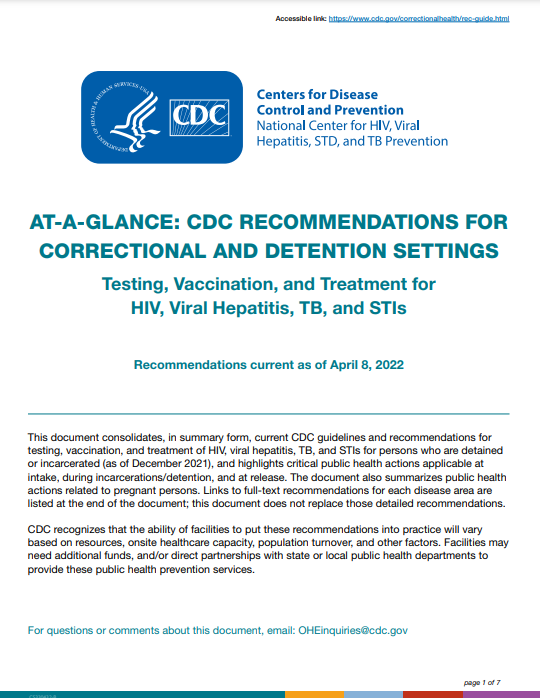CDC Recommendations for Correctional and Detention Settings
Cross-posted from Centers for Disease Control and Prevention

Dear Colleagues:
We are pleased to share a new quick reference document, CDC recommendations for correctional and detention settings. This new resource summarizes testing, vaccination, and treatment recommendations for HIV, viral hepatitis, sexually transmitted infections (STIs), and TB and highlights critical public health actions applicable at intake, during incarceration/ detention, and at release. About 4% of women entering US prisons or jails are pregnant, the document also summarizes public health actions related to persons who are pregnant.
Correctional health is important to us because a higher proportion of people in correctional settings have, or are at risk for HIV, viral hepatitis, TB, and STIs because of social and economic factors, mental and substance use disorders, a history of experiences with homelessness, sex work, or injection drug use. Compared with the general population, prevalence of HIV, viral hepatitis, TB, and STIs is higher among people who are incarcerated:
- HIV – 3 times higher in state and federal prisons
- Hepatitis C – 10 times higher in jails and prisons
- TB – 6 times higher in jails and federal prisons
- STIs – higher rates of chlamydia and gonorrhea among people aged ≤35 years in juvenile and adult detention facilities
Policymakers, administrators, and providers can improve the health of incarcerated people by supporting and implementing CDC recommendations starting when people enter the facility through to reentry into their communities. The ability of facilities to put these recommendations into practice will vary based on resources, onsite healthcare capacity, population turnover, and other factors.
Leadership, providers and staff in a correctional/detention facility or criminal justice system can:
- Compare the summary to current policies and discuss opportunities to address gaps.
- Routinely talk to local or state health departments and discuss implementation of the CDC recommendations.
- Use the document for training and orienting staff.
Public health organizations can:
- Distribute the document to correctional and detention facilities, Department of Corrections, or other criminal justice organizations in their jurisdictions.
- Assist facilities with questions about implementing the recommendations in their facilities.
- Talk to local governments about the importance of testing and treating these infections or conditions to protect the health of people under custody and the communities to which they will return.
Correctional health is community health. Each of you is part of a network of correctional organizations. Together, we can improve the health of people who are incarcerated or detained, their families and the communities to which most people return by testing and treating HIV, viral hepatitis, STIs, and TB while people are incarcerated or detained. The new resource is an important tool in this effort. Please contact Dr. Mariel Marlow at mmarlow@cdc.gov for questions or comments. We also encourage you to stay connected to news and updates about CDC’s correctional health work and other resources through the bimonthly Connections newsletter.
Thank you for your dedication to providing correctional health care services, especially in the wake of the unique challenges created by the COVID-19 pandemic, and your ongoing commitment to prevent and control HIV, viral hepatitis, STIs, and TB in correctional settings.
Sincerely,
/Jonathan Mermin/
Jonathan H. Mermin, MD, MPH
RADM and Assistant Surgeon General, USPHS
Director
National Center for HIV, Viral Hepatitis, STD, and TB Prevention
Centers for Disease Control and Prevention
Stay connected: @DrMerminCDCExit Disclaimer & Connections
/Donna Hubbard McCree/
Donna Hubbard McCree, PhD, MPH, RPh
Associate Director for Health Equity
National Center for HIV, Viral Hepatitis, STD, and TB Prevention
Centers for Disease Control and Prevention
www.cdc.gov/nchhstp/